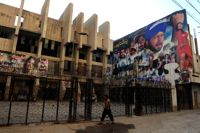Porn in the Land of the Pure

Dark and smoky, the cinema hall reeks of hashish. An overly made-up woman on screen in provocatively figure-hugging clothes dances suggestively to the beat of loud music. The audience, all men, cheer and whistle. The music stops, the scenes get racier and sexually titillating. The crowd abandons all caution. The whistles turn to grunts and growls, chairs begin to bang.
A porn film show is under way right under the nose of the religious-political parties, the Taliban extremists, and the government, at a cinema theatre in Peshawar, the capital city of the most conservative province of Pakistan — Khyber Pakhtunkhwa (KP).
Khyber Pakhtunkhwa, and Peshawar in particular, continue to reel from bomb attacks on girls’ schools and even shrines. Shops selling CDs, and net cafes have been sporadically attacked. Billboards showing women have been defaced or pulled down. Yet, cinemas showing porn continue to flourish.
'Every show in those cinemas is house-full,' says Lala Fida Mohammad Khan, former producer of films in the local language Pushto, and who now runs a cinema in the garrison city Rawlapindi next door to capital Islamabad.
'Everyone knows what fare each cinema churns out, everyone is involved. Daily three shows are run and on Sundays there is a morning matinee as well. On the auspicious Eid days, there are usually five shows so people can come right after the congregation.'
The hundreds of thousands of rupees in bribes or 'monthlies' that cinema owners pay as protection money ensures their business continues uninterrupted, says Khan.
The Shama cinema in Peshawar is owned by the Bilour family, some of whose members are in the Awami National Party that holds a majority in the province. 'They had three cinemas,' says Khan, 'one was attacked several years back so two of these have been turned into shopping plazas, and the one that remains shows porn films.'
There are just nine cinemas left in Peshawar (five have been turned into commercial plazas). Of these, says Aijaz Gul, a well-known film critic, only one run by the Pakistan Air Force 'avoids' porn.
Since the Taliban started wielding power in the province, says Khan, two cinemas have been attacked, but only from outside. A number of cinema hall owners were kidnapped for ransom. 'They paid huge sums and got themselves freed but have not left their occupation.'
Khan says he stopped making films because 'no one wants to watch clean, decent films; these don’t sell any more.'
'Pushto films have always been infamous for both soft and hard porn,' says Gul, 'though there was a time when clean Pushto films were produced too.'
Younus Qiyasi who has scripted some 22 Pushto films quit the cellular world in the 1980s after 'vulgarity and obscenity became the hallmark of these films,' he says.
Khan remembers the time in Peshawar some two decades ago when 'tickets would be sold out days and weeks in advance' and when cine-goers included women. 'There always was strict purdah, even then, but women went to the theatre and sat in family boxes. Now, with the kind of trash shown in cinemas, even if it is not porn, there is no question of women venturing into cinema houses in Peshawar,' he tells IPS.
Film trade is at its lowest generally, and only the lifting of the ban on exhibiting Indian films in 2006 gave Pakistan cinema halls a new lease of life.
Just a little over 200 cinema halls are left, down from 700 in 1977. The Pakistan film industry produced just 20 films last year, of which five were in the national Urdu language, seven in Punjabi and eight in Pushto.
Qiyasi says the men watching the porn films are 'mostly Afghan mohajirs (refugees from Afghanistan who are also ethnically Pakhtuns), not Pakhtuns (natives of KP).' Khan says 'it would be rare to see Pakhtuns venturing into such places.'
Afghan refugees mostly fled during the 1980s Soviet war. According to the UN Refugee Agency (UNHCR), there are 1.7 million registered Afghan refugees still based in Pakistan. A majority of them are in KP, the tribal regions, and parts of Balochistan province.
After 30 years, there seems to be growing disenchantment among the local Pakhtuns with the Afghans who have taken over many businesses and done well for themselves.
Pakhtuns comprise over 15 percent of Pakistan's population (174 million) and an estimated 42 percent of the population in Afghanistan (35 million).
In Nishtarabad, Peshawar’s wholesale DVD and CD market, which houses some 180 shops, a whole new world of films on CDs is doing roaring business, especially among Afghans.
Musafir Khan has been in the business since 1991. He gets about two Pushto films made on CD in a month. 'These are mini-films and cost me anywhere between 300,000 to 350,000 rupees (about 3,300 — 3,900 dollars) for the production, and on top I pay the producer 10,000 rupees (110 dollars) for his service.
'The day it is released we sell about 12,000 CDs at 35 rupees (38 cents) per film.' But business is down, he says. Earlier he would sell almost 30,000 CDs on the day of release of the film. 'These are clean films and can be seen with family,' he says.
According to Fida Khan, these mini-films usually take no more than ten days to produce and three weeks to edit. The shopkeepers who finance these sell them all across Pakistan and even across the border to Afghanistan and beyond. 'These travel as far as Kabul, Jalalabad, Dubai and even London,' says Khan. 'These films are decent family-type movies.' Khan says cinema halls now hook digital projectors to DVDs and CDs and show films at a fraction of the price they would have to pay to buy the older 35 mm print films. These films are usually made in Punjab province with little known actors and later dubbed into Pushto.
© Inter Press Service (2012) — All Rights ReservedOriginal source: Inter Press Service
 Global Issues
Global Issues